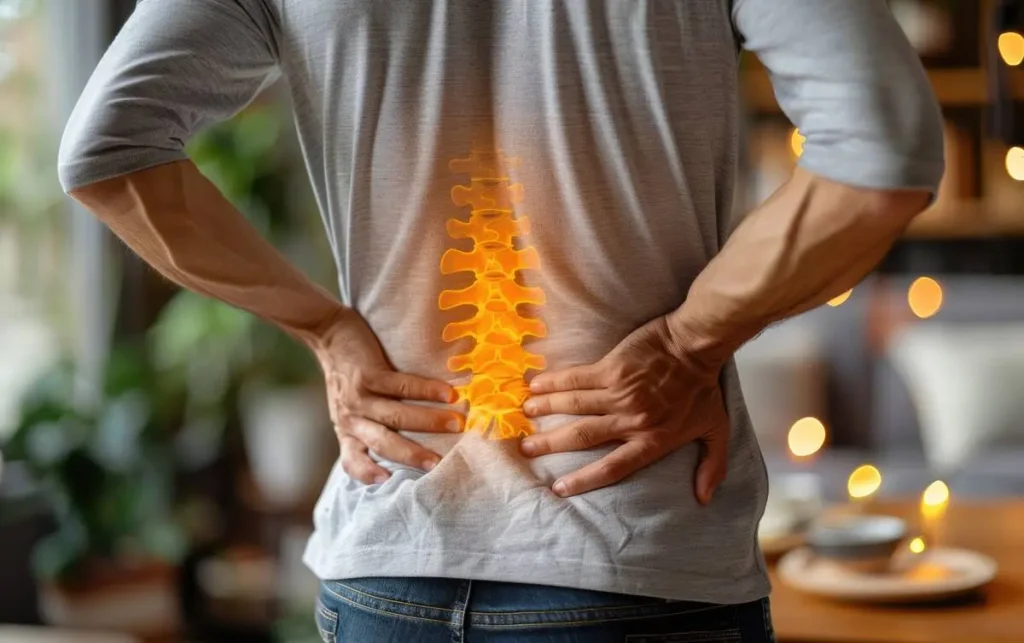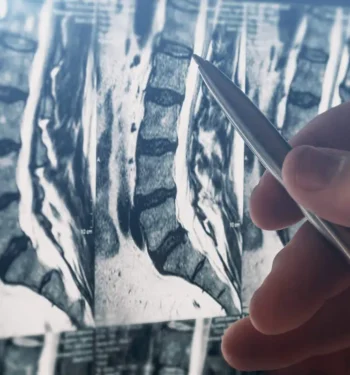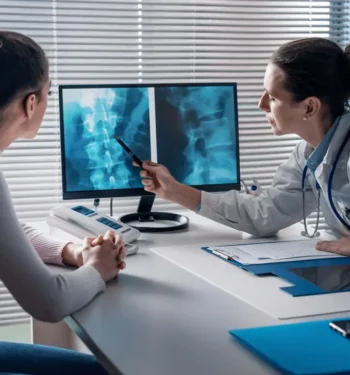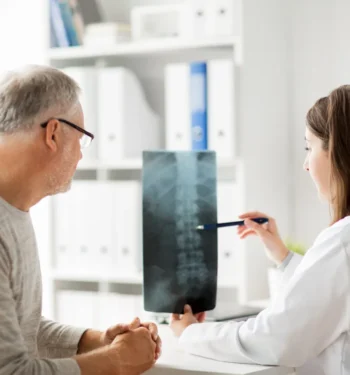
Introduction to Lumbar Spinal Stenosis
Lumbar spinal stenosis is a condition in which the spaces within your lower spine narrow, often compressing the nerves that travel through the back. This narrowing can cause discomfort, tingling, numbness, and sometimes weakness in the legs or lower back. It’s a diagnosis that affects countless individuals, particularly as we age, but it is important to remember that with the right knowledge and care, hope and healing are possible. Understanding the nature of lumbar spinal stenosis is a first step in successful management and improved quality of life.
Definition of Lumbar Spinal Stenosis
Spinal stenosis is defined as the narrowing of the spaces in your spine, specifically in the lumbar (or lower back) region, when referring to lumbar spinal stenosis. This occurs most often because of age-related changes but may also result from injury, inherited conditions, or other diseases. The narrowing can press on the spinal cord and nerves, leading to the classic symptoms many patients experience. This definition helps explain why certain symptoms, such as pain or numbness, occur and underscores the significance of properly identifying your condition.
Prevalence and Affected Population
Lumbar spinal stenosis is especially common among adults over age 50, but younger people can be affected too, particularly if there is a history of spinal injury or inherited disorders. With a growing aging population, this diagnosis impacts millions of people, making it a leading cause of back pain and limited mobility in older adults. Understanding that you are not alone can be a reassuring step on your healing journey.
Importance of Proper Diagnosis
An accurate diagnosis of lumbar spinal stenosis is crucial; mistaking it for other sources of back pain may delay relief and effective care. Back and spine specialists use a combination of medical history, physical examination, and imaging studies to pinpoint your condition before tailoring the treatment plan to you. An early, precise diagnosis empowers you to take control, make informed decisions, and begin your journey to recovery.
If you or a loved one is experiencing symptoms of spinal stenosis, don’t hesitate to seek help from a specialist. For compassionate, expert evaluation and care, ask your doctor about Goodman Campbell to put yourself on a path forward to relief and renewed mobility.
What Are Common Lumbar Spinal Stenosis Symptoms?
Recognizing the symptoms of lumbar spinal stenosis is essential to taking your first steps toward relief and a better quality of life. Often, the earliest sign is lower back pain, which can slowly progress, causing frustration and impacting your ability to enjoy daily activities. Other hallmark lumbar spinal stenosis symptoms include numbness or tingling in the legs, heaviness, cramping, or weakness, particularly when standing or walking for long periods. These discomforts tend to improve with rest or when you lean forward, such as when sitting or pushing a shopping cart.
As symptoms progress, they can increasingly limit your lifestyle and independence. You may notice that you’re unable to walk as far as you used to and need more frequent rest breaks. Some patients experience trouble with balance, leading to a greater risk of falls and anxiety about moving around. The impact of spinal stenosis can extend to cherished hobbies, family outings, and even routine activities like shopping or gardening. It’s important to know that symptoms vary from person to person; some may have mild discomfort, while others face disabling pain or weakness.
Recognizing Red Flags That Need Urgent Medical Attention
While most symptoms build gradually, certain warning signs require immediate attention. Sudden loss of bladder or bowel control, profound numbness in the “saddle” area (around the inner thighs and groin), or rapidly worsening leg weakness can indicate severe nerve compression. These red flags are considered medical emergencies, and prompt evaluation can make a critical difference in your outcome.
When Should You Seek Help For Lumbar Spinal Stenosis?
If persistent back pain, numbness, tingling, or weakness start interfering with your daily life, do not delay seeking help. Early evaluation by a skilled spine specialist can lead to an accurate diagnosis and a personalized care plan, opening the door to greater mobility and hope for the future. Remember, proactive care from a team whose focus is back and spine care can prevent symptoms from progressing and help you return to the activities you love.
You are not alone on this journey. Ask your doctor about Goodman Campbell to take the first step toward reclaiming your comfort and vitality.
How Do You Treat Spinal Stenosis of the Lumbar Region?
Treating lumbar spinal stenosis involves a personalized approach that may include both nonsurgical and surgical options, depending on the severity of symptoms, the progression of the condition, and your overall health and lifestyle goals. The aim is always to control pain, restore function, and help you reclaim the joys of daily living. Many patients start with conservative therapies, reserving surgery for those whose symptoms persist or worsen despite these treatments. Working with an experienced, knowledgeable team is key to determining what approach can help you live your life to the fullest.
Nonsurgical Treatments: Physical Therapy, Pain Management, Medication
For many, the first line of defense for lumbar spinal stenosis treatments includes physical therapy, gentle exercise, and structured pain management. Physical therapy strengthens the muscles around the spine, improving mobility and reducing strain on affected areas. Lifestyle enhancements — rest, heat and cold therapy, and supportive devices — can offer relief and help you stay active.
Role of Injections and Minimally Invasive Options
For those whose pain persists, corticosteroid injections can reduce inflammation and offer significant, if temporary, relief. Minimally invasive procedures — micro lumbar discectomy or the latest endoscopic techniques — can address the source of nerve compression with less trauma, typically leading to faster recovery. The expertise of a multidisciplinary team that includes an interventional pain management provider specializing in spine care ensures these options are used appropriately for your unique needs.
What Is the Newest Treatment for Spinal Stenosis?
Innovation has brought forth advanced methods such as minimally invasive lumbar decompression and interspinous process spacers, which can relieve pressure without more invasive surgery. These procedures are linked to shorter hospital stays and faster returns to activity. At the forefront, neurosurgery centers like Goodman Campbell offer the latest in surgical and nonsurgical care tailored to you.
Importance of a Multidisciplinary Approach
Successful treatment of lumbar spinal stenosis is about much more than a single intervention. The most positive outcomes come from teams, like those at Goodman Campbell, that coordinate physical therapists, interventional pain specialists, neurosurgeons, and compassionate patient support. This holistic view helps patients move from fear and frustration to empowerment and relief.
Your journey to greater mobility and restored freedom begins with a conversation. Ask your doctor about Goodman Campbell, global leader in spine care and the epicenter of clinical research and neurosurgery training in the United States.
What Not to Do With Lumbar Spinal Stenosis?
Lumbar spinal stenosis often requires not just specific treatments, but also positive lifestyle adjustments and an informed understanding of the activities that may make symptoms worse. Recognizing what not to do with this condition can make a significant impact on your comfort, safety, and long-term outcomes. Certain habits or movements may intensify pain, pressure on nerves, or risk of injury, making it essential to thoughtfully tailor your daily choices with professional guidance.
High-Impact Activities To Avoid
It is wise to steer clear of activities that repeatedly jar or compress the spine, such as running, jumping, or high-impact sports. These movements can increase stress on the lower back and worsen the narrowing of the spinal canal, intensifying symptoms and potentially accelerating degeneration. Instead, focus on low-impact activities such as walking, swimming, or cycling, which foster mobility while protecting your spine.
Movements and Exercises That May Worsen Symptoms
Certain exercises and stretches, particularly those that involve excessive back extension (bending backward), can aggravate lumbar spinal stenosis symptoms. Heavy lifting, twisting, or abrupt, jerky motions should also be avoided, as they may further compress the nerves and escalate discomfort. Seeking guidance from a physical therapist specializing in spine care can help you safely build strength and flexibility without risking your well-being.
Lifestyle Adjustments for Comfort and Safety
A supportive spinal stenosis lifestyle often involves adjusting your posture, workspace, and routines. Use ergonomic seating, maintain gentle activity, and take regular breaks to ease back pressure. Proper footwear, assistive devices if needed, and mindful self-care (such as warming up and cooling down before and after activities) all support spine health. Balancing activity with periods of rest can help minimize symptom flares and promote overall wellness.
The Importance of Professional Guidance
Above all, partnering with healthcare professionals ensures you make choices suited to your unique needs. A tailored plan from a knowledgeable provider reduces the risk of worsening your condition and helps you stay active and independent. For compassionate, expert support and the latest innovations in spine care, request an appointment at Goodman Campbell. Our experienced team can guide you every step of the way to a safer, healthier future.
Take charge of your comfort and movement. Request an appointment or ask your doctor about Goodman Campbell today.
Can You Live a Long, Normal Life With Spinal Stenosis?
Can you live a long, normal life with spinal stenosis? Absolutely. In fact, many people with lumbar spinal stenosis go on to enjoy long, fulfilling lives. While the condition may introduce challenges, especially as symptoms fluctuate, progressive treatments and customized care plans can help you manage chronic symptoms and preserve your independence, mobility, and well-being. The key is timely diagnosis, proactive management, and partnering with a specialized care team to develop a strategy that fits your lifestyle and goals.
Life Expectancy and Prognosis With Lumbar Spinal Stenosis
Having lumbar spinal stenosis usually does not impact your life expectancy. Most individuals with this condition, when under proper care, can expect to live just as long as those without it. The main difference lies in the quality of life, which depends on how well your symptoms are managed. Advances in physical therapy, medications, minimally invasive procedures, and surgery when needed mean there are more ways than ever to preserve function and reduce discomfort.
Managing Chronic Symptoms for a Fulfilling Life
Proactive management is crucial for maintaining a rewarding quality of life with lumbar spinal stenosis. Consistent physical therapy, gentle lumbar spinal stenosis exercises, a healthy diet, and regular medical checkups help keep you moving and minimize pain. It’s important to avoid activities that worsen your symptoms and to work closely with your healthcare provider to personalize your plan. Remember, flare-ups may occur, but with support, many patients continue to work, travel, and enjoy the activities they love.
Success Stories and Outlook With Modern Treatments
Thanks to advancements in the field, countless spinal stenosis patients have experienced renewed hope and improved lifestyles. From stories of seniors returning to golf after minimally invasive treatments to individuals rediscovering daily activities without debilitating discomfort, there is reason for optimism. Whether you are newly diagnosed or have been living with symptoms for years, it is never too late to seek guidance and pursue a brighter, more active future.
What Happens if You Do Nothing for Spinal Stenosis?
Choosing to leave spinal stenosis untreated can lead to significant worsening of symptoms, decreased quality of life, and, in rare cases, life-threatening complications. As the condition progresses, the spinal canal narrows further, putting increased pressure on the nerves and spinal cord, which can result in permanent nerve damage. It is crucial to recognize that while some mild cases might remain stable, most people experience escalating pain, loss of mobility, and decreasing ability to participate in daily activities if care is not sought. Getting expert advice and early treatment can make a profound difference in preventing complications and preserving independence. Request your appointment with Goodman Campbell to begin your path forward.
What Are the Risks of Untreated Lumbar Spinal Stenosis?
If lumbar spinal stenosis is not addressed, the natural trajectory usually involves the gradual intensification of symptoms. Patients typically notice increasing back and leg pain, numbness, and weakness. Over time, these changes may make walking or standing for extended periods difficult or impossible, and you might begin to lose control over bladder and bowel function — a sign of severe nerve involvement. Untreated spinal stenosis can also cause permanent nerve injury, leading to irreversible loss of strength or feeling in the leg.
What Are the Final Stages of Spinal Stenosis?
The final stages are characterized by profound impairment: chronic, unmanageable pain, inability to walk or stand, loss of muscle function, and possibly cauda equina syndrome, which demands emergency intervention. Cauda equina syndrome manifests as sudden incontinence and numbness in the saddle area, and it can result in permanent paralysis if not treated swiftly. Even before reaching this stage, increased disability and dependence on others for daily care may develop. Though rare, complications arising from immobility, such as blood clots or infections, can become life-threatening.
Can Spinal Stenosis Kill You?
It is uncommon for spinal stenosis itself to be directly fatal. However, neglecting to address the seriousness of advanced symptoms can result in emergencies — severe nerve injury, paralysis, or complications secondary to immobility — that can jeopardize your overall health. Most importantly, ignoring symptoms can severely limit your life’s joy, fulfillment, and independence, making proactive care not just a matter of health, but also of vitality.
When Should You Seek Proactive Treatment?
If you experience progressive pain, weakness, balance problems, changes in bladder or bowel control, or find daily activities becoming increasingly difficult, don’t wait. Early diagnosis and a proactive treatment plan open the door to relief, restored function, and an improved quality of life. A multidisciplinary team that includes neurosurgeons who specialize in back and spine care and interventional pain management physicians can customize care to your needs, sometimes even avoiding surgery through advanced interventions and lifestyle changes. For compassionate, expert care, request an appointment with Goodman Campbell.
Which Exercises and Lifestyle Changes Help With Lumbar Spinal Stenosis?
Embracing a proactive approach to lumbar spinal stenosis means adapting daily habits and routines to support your spine and overall well-being. Thoughtfully selected exercises and lifestyle changes can dramatically improve comfort, mobility, and quality of life for individuals living with spinal stenosis. Working within safe boundaries, staying dedicated to self-care, and collaborating with your healthcare team are keys to finding relief and maintaining independence.
Which Exercises Are Safe and Effective for Lumbar Spinal Stenosis?
Gentle stretching, low-impact aerobic activities, and core-strengthening exercises are commonly recommended to support a healthy back and reduce pain. Stretching the hamstrings, hips, and lower back, as well as performing gentle pelvic tilts or knee-to-chest stretches, can relieve tightness and improve flexibility. Always prioritize good form, and never push through sharp pain — listening to your body is essential.
How Can Lifestyle Adjustments Ease Spinal Stenosis Symptoms?
A spinal stenosis lifestyle centers around protecting your back throughout the day. Simple habits such as practicing good posture, using supportive chairs, arranging your workspace ergonomically, and avoiding heavy lifting can make a significant difference. Weight management is equally important; maintaining a healthy weight lightens the load on your spine and may reduce discomfort. Incorporating regular, varied movement throughout your day can help maintain overall fitness and encourage a positive outlook.
What At-Home Activities Support Spinal Health?
Consistency is key when engaging in self-care for spinal stenosis at home. Periodic gentle stretching, warm compresses, and mindful breathing or relaxation techniques help manage tension and pain. If you experience worsening symptoms during an activity, immediately pause and rest. Keeping a daily log of your pain, activity, and overall energy levels can provide helpful insight for you and your care team.
When Should I Consult a Specialist About My Exercise Plan?
If you are new to exercise, recently diagnosed, or experience persistent or severe symptoms, consulting a specialist, such as a physical therapist, ensures safety and effectiveness. They can develop a personalized plan to strengthen muscles, protect spinal alignment, and prevent further injury. Your journey toward a healthier back and spine doesn’t have to be taken alone; your care team is there to guide you every step of the way.
Ask your doctor about Goodman Campbell or request an appointment today for compassionate, expert guidance on integrating safe exercises and lifestyle improvements into your lumbar spinal stenosis management plan.
Conclusion: Taking Control of Lumbar Spinal Stenosis
Living with lumbar spinal stenosis can feel overwhelming, but a healthcare team you trust can help alleviate the physical and emotional stress. Taking control begins with understanding your symptoms, recognizing when to seek medical advice, and making informed decisions about your care. The advances in diagnosis and treatment, including both nonsurgical and minimally invasive surgical options, mean that more people than ever are leading active, fulfilling lives after facing a spinal stenosis diagnosis. Early intervention, consistent management, and a supportive healthcare team make a tremendous difference.
One of the most important steps you can take is to proactively approach your spinal health. Whether you’re dealing with new symptoms or have been managing back pain for years, prioritizing regular check-ups, healthy lifestyle habits, and gentle movement can make each day more comfortable and rewarding. When challenges arise, don’t hesitate to seek expert evaluation to avoid complications and improve your quality of life. Asking questions and working closely with a specialized spine care team helps you become empowered, heard, and optimistic about your future.
Consulting with back and spine care experts, such as those at Goodman Campbell, can open doors to the latest treatments, expert guidance, and ongoing support tailored to your individual needs. With their help, remarkable recoveries are possible. Take the first step. Request an appointment or ask your doctor about Goodman Campbell and get back to better.


